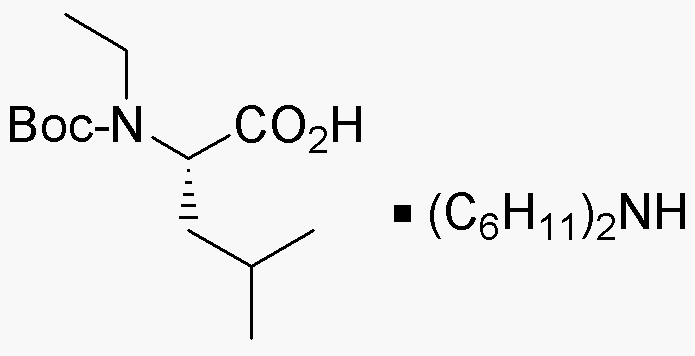Boc-N-ethyl-L-leucine dicyclohexylammonium salt is widely utilized in research focused on:
- Peptide Synthesis: This compound serves as a protecting group in peptide synthesis, allowing researchers to selectively modify amino acids without affecting the overall structure.
- Pharmaceutical Development: It is used in the formulation of drug candidates, particularly in optimizing the solubility and stability of compounds, which is crucial for effective delivery.
- Biotechnology: In biotechnological applications, it aids in the development of enzyme inhibitors and other biologically active compounds, enhancing the efficiency of drug discovery processes.
- Research on Protein Interactions: This chemical is valuable in studying protein-ligand interactions, helping scientists understand binding mechanisms and improve drug design.
- Custom Synthesis: Its versatility allows for custom synthesis of derivatives, making it an essential tool for researchers looking to explore new chemical entities and their potential applications.
General Information
Properties
Safety and Regulations
Applications
Boc-N-ethyl-L-leucine dicyclohexylammonium salt is widely utilized in research focused on:
- Peptide Synthesis: This compound serves as a protecting group in peptide synthesis, allowing researchers to selectively modify amino acids without affecting the overall structure.
- Pharmaceutical Development: It is used in the formulation of drug candidates, particularly in optimizing the solubility and stability of compounds, which is crucial for effective delivery.
- Biotechnology: In biotechnological applications, it aids in the development of enzyme inhibitors and other biologically active compounds, enhancing the efficiency of drug discovery processes.
- Research on Protein Interactions: This chemical is valuable in studying protein-ligand interactions, helping scientists understand binding mechanisms and improve drug design.
- Custom Synthesis: Its versatility allows for custom synthesis of derivatives, making it an essential tool for researchers looking to explore new chemical entities and their potential applications.
Documents
Safety Data Sheets (SDS)
The SDS provides comprehensive safety information on handling, storage, and disposal of the product.
Product Specification (PS)
The PS provides a comprehensive breakdown of the product’s properties, including chemical composition, physical state, purity, and storage requirements. It also details acceptable quality ranges and the product's intended applications.
Certificates of Analysis (COA)
Search for Certificates of Analysis (COA) by entering the products Lot Number. Lot and Batch Numbers can be found on a product’s label following the words ‘Lot’ or ‘Batch’.
Numéro de catalogue
Numéro de lot/série
Certificates Of Origin (COO)
This COO confirms the country where the product was manufactured, and also details the materials and components used in it and whether it is derived from natural, synthetic, or other specific sources. This certificate may be required for customs, trade, and regulatory compliance.
Numéro de catalogue
Numéro de lot/série
Safety Data Sheets (SDS)
The SDS provides comprehensive safety information on handling, storage, and disposal of the product.
DownloadProduct Specification (PS)
The PS provides a comprehensive breakdown of the product’s properties, including chemical composition, physical state, purity, and storage requirements. It also details acceptable quality ranges and the product's intended applications.
DownloadCertificates of Analysis (COA)
Search for Certificates of Analysis (COA) by entering the products Lot Number. Lot and Batch Numbers can be found on a product’s label following the words ‘Lot’ or ‘Batch’.
Numéro de catalogue
Numéro de lot/série
Certificates Of Origin (COO)
This COO confirms the country where the product was manufactured, and also details the materials and components used in it and whether it is derived from natural, synthetic, or other specific sources. This certificate may be required for customs, trade, and regulatory compliance.


